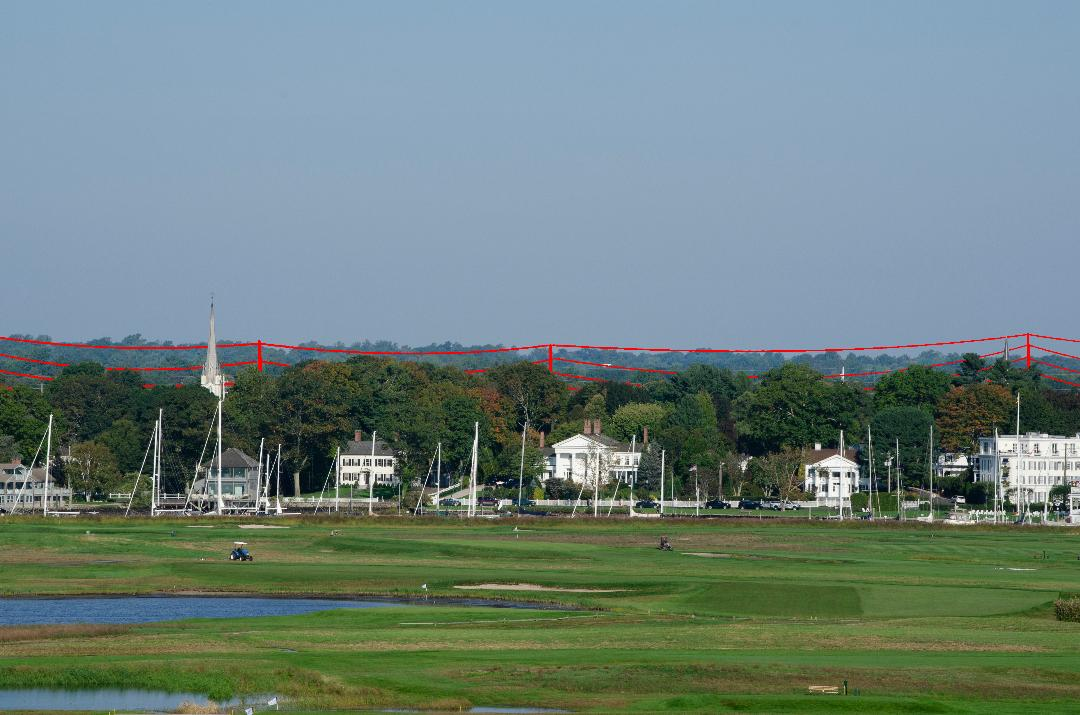
FAIRFIELD — The National Trust for Historic Preservation has thrown their support behind local advocates opposing a $225 million proposed project by United Illuminating, warning of the plan’s “potentially devastating” impacts to historic properties.
Since 2017, the utility company has been replacing aged transmission lines along the Metro North rail line to strengthen its grid, and has completed work in West Haven, Milford and Stratford.
But UI’s most recent proposal for Fairfield, Southport and Bridgeport has sparked opposition from residents, officials and advocacy groups, as it would require 8.6 acres of permanent easements on houses, businesses and historic buildings, 5.8 acres of vegetation clearing and the construction of 68 new monopoles.
Last week, the National Trust for Historic Preservation joined the fray and attempted to intervene in UI’s application process. The group also invited Fairfield, Bridgeport and Southport to join an annual list as some of the most “endangered historic places” in the country.
“We’re hoping that we’ll be able to bring more attention to the impact of this proposed transmission line on historic resources in Southport, Bridgeport and Fairfield,” said Thompson Mayes, chief legal officer for the organization.
In order to carry out the project, the utility company requested approval from the Siting Council in March. The council has granted intervenor status requests — meaning interested parties can present arguments against the project — from residents and advocacy groups, including the town of Fairfield. On Nov. 9, Mayes applied to join the movement.
On Wednesday, Mayes told CT Examiner that the council has not adequately taken the potential impacts on nearby historic properties into consideration.
“They’ll have the transmission line running over their property, or even through their property,” Mayes said. “So, really potentially devastating impacts.”
Included in the scope of UI’s project is the Southport Historic District, the Mary and Eliza Freeman Houses, the 134-year-old Pequot Library and houses constructed in the 18th century. Because the proposed monopoles could range from 100 to 135 feet tall, Mayes argued the project would have an “incredible visual impact” on the properties.
A national invitation
Along with intervening in the Siting Council application, National Trust invited Fairfield, Bridgeport and Southport to apply for its 2024 “America’s 11 Most Endangered Historic Places” list which, Mayes said, is somewhat unusual.
“There are many threatened places throughout the United States, and many of them hope to bring attention to their sites by being listed in the 11 most endangered list,” he said. “Only a small percentage of those end up being invited to submit a full application.”
According to the National Trust’s website, the list helps historic preservationists to raise awareness and rally support for threatened sites.
While the Siting Council must rule on the project application by March, the final endangered historic places list will not be published until May. Regardless, Mayes said the invitation alone emphasizes that the impacts on local properties would be “significant.”
Jane Montanaro, executive director of Preservation Connecticut, told CT Examiner on Wednesday that her organization found out about the project through concerned Southport residents, who then reached out to National Trust for guidance.
Preservation Connecticut is currently working with members of the Pequot Library to construct an argument, find supporting materials and draft the final application, Montanaro said.
Asked if a spot on the national list has helped preserve other Connecticut properties, Montanaro pointed to the Freeman Houses in Bridgeport, one of the 11 places listed in 2018.
“It really was able to broaden the outreach for the organization and build support for saving those houses and bring funding in,” Montanaro said. “It’s been a long road, but that was a critical first step in really turning that organization around.”
The Mary and Eliza Freeman Center for History and Community has been working for years to restore and preserve the houses which, the center’s website explains, are listed on the National Register of Historic Places for their significance to African Americans and women. For years, the buildings have been under threat of demolition.
After making the 2018 list, the center received grants from Connecticut Humanities, a preservation grant from the state Department of Economic and Community Development, National Trust’s African American Cultural Heritage Action Fund and Preservation Connecticut.
But due to the new UI plan, Montanaro said, the Freeman houses are still at risk.
“Now they’re under threat again with this proposal from UI,” she said. “So we’ll be working with the Freeman Houses and developing some of the content for this application.”
Andrea Ozyck, a Southport resident and co-founder of Sasco Creek Neighbors Environmental Trust Inc., urged the importance of support from national and state preservationists.
“I think we’re hitting a critical mass here,” Ozyck told CT Examiner.
Ozyck said she and her husband founded the nonprofit in August after discovering the impact of UI’s proposal. The organization has since held a well-attended protest and earned intervenor status in the Siting Council application. Ozyck said the National Trust’s opposition has helped increase public awareness as well.
“Based on where the poles and the wires will be and the size of the easements that are required on those properties, a number of them will either become nonconforming — which means there’s a significantly high risk of complete seizure — or they could be deemed dangerous because the wires are overtop of the houses,” she said.
She added that the vegetation clearing would also shift Fairfield’s landscape from “charming and historic” to “industrial,” as the utility company may cut down trees that block their existing monopoles. Without its charm, Ozyck said, prospective residents and businesses may be less likely to move to Fairfield.
An alternative
Ozyck clarified that her organization’s goal is not to keep UI from strengthening its grid, but to encourage the company to find a less invasive alternative, such as burying the lines underground.
Ozyck and Mayes said they hope National Trust’s backing will motivate the Siting Council to request a new plan.
On Wednesday, UI spokesperson Sarah Wall Fliotsos defended the company’s current proposal.
She said the company has submitted the “most prudent plan” to the Siting Council, as well as multiple alternative proposals. According to its application, UI disclosed an underground option but explained why it was eliminated.
“Ultimately, the Siting Council will make a comprehensive determination on which proposal is most fiscally sound, most environmentally responsible, and best reflects their decisions on previous phases of the program,” Wall Fliotsos said.
She added that the utility company worked closely with federal, state and municipal organizations to identify project proposals, and urged the importance of upgrading the technology.
“Upgrading and improving the century-old transmission infrastructure across UI’s service territory is essential to UI’s fundamental obligation: Ensuring power reliability and resiliency despite a changing climate and in the midst of preparing for a clean energy future,” she said.


